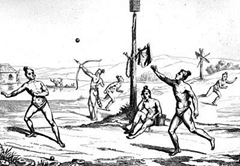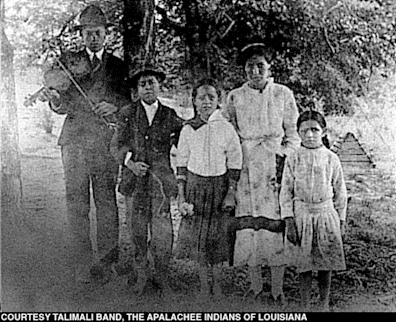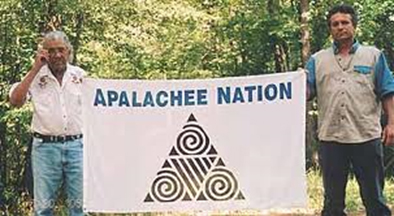The Spirit of the Apalachees
There has been a human presence in Franklin County for thousands of years.
From at least A.D. 1000, a group of farming Indians known as the Apalachee lived in northwest Florida. Their territory extended from the Aucilla River to the east and the Ochlockonee River to the west, and from what is now the Georgia state line to the Gulf of Mexico. Prior to European contact, there were at least 50,000-60,000 Apalachees. They were a strong and powerful tribe living in widely dispersed villages. Other tribes respected the Apalachees because they belonged to an advanced Indian civilization, they were prosperous, and they were fierce warriors.
For food, they grew corn, beans and squash. Men prepared the fields and women tended the crops. Men also hunted bear, deer and small game, while women gathered nuts and berries. Traditionally the men wore deerskin loincloths and women wore Spanish moss skirts. When preparing for battle, the men painted their bodies with red ochre and put feathers in their hair.

The Apalachees played a ball game that was a religious exercise as well as a sport. One village would challenge another to a match, and the two teams would have up to 100 players each. They used a hard clay ball about the size of a golf ball covered with buckskin. Players propelled the ball with their feet toward the goal post which was a pole topped with a stuffed eagle in a nest. They played the ball game in the spring and summer, and dedicated it to the gods of rain and thunder to ensure rain for their crops.
One feature of Apalachee society was their large ceremonial mounds. The largest prehistoric Apalachee settlement at Lake Jackson north of Tallahassee originally consisted of seven large earthen mounds. Some of the mounds had structures on top, and it is generally believed that the largest mound within a complex was the site of the chief’s house.
The Apalachee of northwest Florida were among the first indigenous North Americans encountered by European explorers. In 1539, Hernando de Soto wintered in Apalachee Province. His expedition members stayed in the sixteenth century Apalachee capital village called Anhaica. They received a hostile reception and were under almost constant attack from the Apalachees. The European presence eventually took its toll on the Apalachees from continual skirmishes and, eventually, contagious diseases that were introduced by the explorers. When epidemics and the threat of foreign attacks brought about a loss of faith in the traditional customs and leadership, the Apalachees converted to Catholicism. Anhaica, became one of the first missions established in Apalachee Province by Spanish Franciscan priests around 1633. It eventually relocated to present day Tallahassee and renamed San Luis de Talimali. In 1704 the mission system collapsed under the weight of British attacks. Many of the Apalachee who survived moved northwest to French-held Mobile, an area encompassing what are now southeastern Mississippi and southwestern Alabama.
Time passed and these descendants of Mission San Luis disappeared from American history books for the next 200 hundred years. However, about 300 Apalachee descendants—today the only known descendants of Florida’s original inhabitants—have survived. They currently live in Louisiana and are seeking state and federal recognition as the Talimali Band of the Apalachee Indians of Louisiana, Inc. Apalachee people remember their collective past while planning for the future, secure in the knowledge of who they are and from whence they came.

An early twentieth-century photograph records members of the Talimali Band of the Apalachee Indians living in Louisiana. Standing far right is the song of Francis Vallery - former chief Gilmer Bennett.

Former Tribal Chief Gilmer Bennett and his son Art, the current Tribal Chief, holding the Apalachee Nation flag given to them by Bonnie McEwen, Mission St. Luis Historic Site, Tallahassee, Florida, 2005. Photograph courtesy of the Bennett family.
For more information, visit: https://www.apalacheetalimaliband.com/
Information obtained from: www.pbchistoryonline.org & http://archive.archaeology.org/online/news/apalachee.html
R/V Apalachee
Other Information
Object reference not set to an instance of an object.

